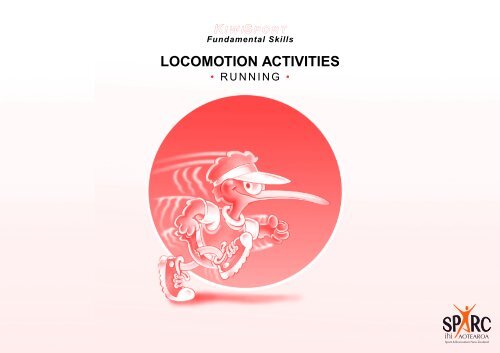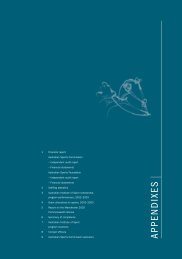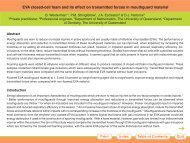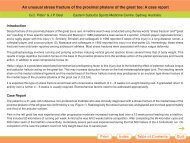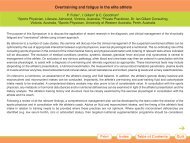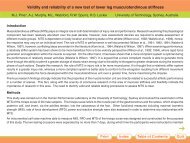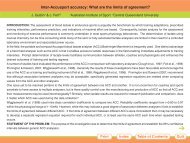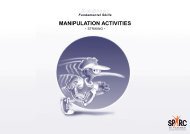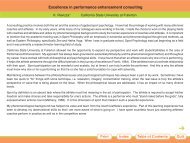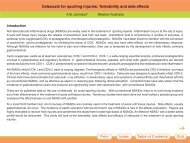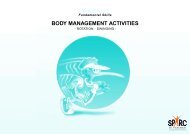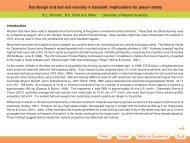LOCOMOTION ACTIVITIES
LOCOMOTION ACTIVITIES
LOCOMOTION ACTIVITIES
Create successful ePaper yourself
Turn your PDF publications into a flip-book with our unique Google optimized e-Paper software.
K IWIS PORT<br />
Fundamental Skills<br />
<strong>LOCOMOTION</strong> <strong>ACTIVITIES</strong><br />
• RUNNING •
Locomotion activities running<br />
KiwiSport Fundamental Skills<br />
RUNNING<br />
The aim of KiwiSport Fundamental Skills is to develop basic sports skills through simple,<br />
enjoyable play activities.<br />
This section contains those which are pertinent to running. They are grouped for:<br />
• Running efficiently.<br />
• Dodging, swerving, evading.<br />
• Quick starting.<br />
• Sustained running.<br />
• Changing pace.<br />
• Running in shallow water.<br />
The activities are generally arranged from the simplest to the most complex.<br />
The activities have been selected with schools specifically in mind but an input of<br />
professional skill and judgement is needed to ensure lively and relevant<br />
programmes. Decisions will need to be made on when and how the activities<br />
are used and what modifications are needed to match age and ability.<br />
The activitites also fill a need outside class programmes. They are useful<br />
for children’s learning and play at any time – lunch time, after<br />
school, sports training, holiday programmes and at home.<br />
Parents and others who play with children in informal<br />
situations should find the ideas particularly helpful.<br />
2
Locomotion activities running<br />
RUNNING EFFICIENTLY<br />
ACTIVITY 14 EXPLORING RUNNING<br />
BEFORE THE ACTIVITY<br />
Grass, hard area.<br />
DURING THE ACTIVITY<br />
Children spread out in defined area.<br />
Explore by asking ‘Can you run.....?’ or ‘Who can run....?’<br />
• fast over a short distance.<br />
• in shapes of objects or animals.<br />
• keeping together in small groups.<br />
• changing direction on a signal.<br />
• forwards, backwards, sideways.<br />
• following a leader.<br />
• varying speed.<br />
• over/along lines.<br />
• around, under, through, over objects.<br />
• around a given circuit.<br />
• while clapping.<br />
• like a machine.<br />
• on the spot/moving.<br />
• beside/behind a partner.<br />
• making your very own path.<br />
• uphill/downhill.<br />
• making up own patterns eg. 6 steps forward, 3 left, 3 back, 4 right or 10<br />
steps fast, 5 slow, 5 medium, or trace out numbers, letters, words.<br />
• concentrating on relaxing – ‘run loose’.<br />
KiwiSport Fundamental Skills<br />
• along a straight line.<br />
• following a leader in a line of four or five. On signal leader drops to back<br />
of the group and the next takes over.<br />
• to destinations – on a set circuit equate a certain number of laps to known<br />
destinations eg. 1 lap = school gate, 3 laps = corner shop,<br />
10 laps = Mary’s home etc<br />
• tall with knees high/driving legs.<br />
• bouncing a ball.<br />
• under a rope.<br />
• through a hoop/a turning rope.<br />
• leaning forwards – change to leaning backwards.<br />
• in funny ways – Who is funniest? – Can we copy?<br />
• in many different ways.<br />
• to touch a series of named objects – a tree, a line, a fence, a goal post.<br />
• imitating TV characters.<br />
• in small spaces without touching anyone.<br />
LOOK FOR<br />
• feeling light.<br />
• sounding quiet.<br />
• feeling tall.<br />
• innovation by children.<br />
3
Locomotion activities running<br />
RUNNING EFFICIENTLY<br />
ACTIVITY 15 KIRI SAYS!<br />
BEFORE THE ACTIVITY<br />
Grass or hard area.<br />
DURING THE ACTIVITY<br />
• Spread out in a defined area with ‘Kiri’ identified. Kiri calls instructions to<br />
the group. If the instruction begins with ‘Kiri says’ the group do what is<br />
said. If the instruction does not begin with ‘Kiri says’ they continue as they<br />
were doing. How few mistakes can you make? Kiri may ask the students to<br />
run quickly, slowly, heavily, or lightly, with short or long strides, with a<br />
forward body lean, upright, in pairs or groups, with straight legs or arms<br />
etc.<br />
LOOK FOR<br />
• running tall/relaxed.<br />
• opposite arm and leg action.<br />
• eyes open – not touching others.<br />
VARIATIONS<br />
• Work in pairs or small groups.<br />
• Use activities other than running.<br />
KiwiSport Fundamental Skills<br />
RUNNING EFFICIENTLY<br />
ACTIVITY 16 FOLLOW ME<br />
BEFORE THE ACTIVITY<br />
Playground, preferably with fixed equipment.<br />
DURING THE ACTIVITY<br />
• Small groups in single file in a defined area.<br />
Leaders lead the group on a route of their choice around the playground,<br />
up ramps, around trees, over obstacles, up and down steps, along lines<br />
etc.<br />
On signal back person runs up to lead.<br />
LOOK FOR<br />
• light, quiet, quick movements.<br />
• keeping the group together.<br />
VARIATION<br />
• Run to musical beat.<br />
4
Locomotion activities running<br />
RUNNING EFFICIENTLY<br />
ACTIVITY 17 MIDNIGHT<br />
BEFORE THE ACTIVITY<br />
Marked large circle with a small circle in centre.<br />
DURING THE ACTIVITY<br />
• Children spaced around the large circle.<br />
When a shared factor is called, eg. birthday month, those children sprint around<br />
the circle, return to their starting points and then try to reach the centre circle<br />
first. On the call ‘Midnight’ all runners race off.<br />
LOOK FOR<br />
• keeping sprinting style when under pressure.<br />
• running with a slight lean in towards the circle.<br />
• keeping arms bent.<br />
• safe passing.<br />
• safety when entering the inner circle.<br />
VARIATIONS<br />
• Number children in threes or fours and call numbers.<br />
• Use Maori numbers.<br />
KiwiSport Fundamental Skills<br />
RUNNING EFFICIENTLY<br />
ACTIVITY 18 CHANGING SPEED<br />
BEFORE THE ACTIVITY<br />
Cones or other markers or existing lines.<br />
DURING THE ACTIVITY<br />
• Markers at 10 metre intervals.<br />
Children line up in waves.<br />
On ‘go’ the first wave runs fast to the first marker, slow to the next, fast to the<br />
next etc.<br />
Second wave starts when the first wave reaches the first marker.<br />
LOOK FOR<br />
• run tall, arms bent and relaxed. Drive arms and knees up to increase speed<br />
again.<br />
VARIATIONS<br />
• Run around a circuit with marked intervals.<br />
• Run around the circuit changing speed on the signal.<br />
• Small groups follow the leader.<br />
• Change the intervals to suit the runners.<br />
5
Locomotion activities running<br />
RUNNING EFFICIENTLY<br />
ACTIVITY 19 HALF AND HALF RELAYS<br />
BEFORE THE ACTIVITY<br />
Marker cones or pegs if there are no lines.<br />
Hall, grass, hard surface, a starting line and a boundary line 3-8 metres apart.<br />
DURING THE ACTIVITY<br />
• Children in fours – two at the starting line and two at the boundary line – facing<br />
each other.<br />
1 runs to tag 2 and stays there.<br />
2 runs to tag 3 and stays there.<br />
3 runs to tag 4 and stays there.<br />
Repeat until all children are back where they started.<br />
VARIATIONS<br />
• Round the back – Formation as above.<br />
Number 1 runs across the area and around the back of number 2 and number 4<br />
then tags number 2 who runs across and around the back of number 3 and tags.<br />
Repeat several times.<br />
• Run and Copy – Formation as above.<br />
1 runs across and stops in front of 2 and begins doing an activity on the spot –<br />
either of own choice or specified by teacher. 2 copies the activity, eg. double<br />
hops and together they do 10 -15 repetitions. 1 stays there and 2 runs across to 3<br />
and performs an ‘on the spot’ activity which 3 copies.<br />
Repeat until everyone is back in their starting positions.<br />
KiwiSport Fundamental Skills<br />
RUNNING EFFICIENTLY<br />
ACTIVITY 20 FIREMAN’S BUCKET<br />
BEFORE THE ACTIVITY<br />
Cones, hoops, or lines to use as markers.<br />
Hall, grass, hard surface, running distance 5-6 metres.<br />
DURING THE ACTIVITY<br />
• Children in groups of three or four lined up one behind the other – all facing<br />
the boundary line.<br />
1, the ‘Fireman’, takes 2’s hand, runs with them to the boundary line, leaves 2<br />
there and runs back to 3.<br />
1 now takes 3 over to the other side, then 4 – all team members are now<br />
opposite where they started.<br />
2 now takes each person in turn back to the other side.<br />
Repeat this sequence until all members have had a turn at being fireman.<br />
LOOK FOR<br />
• matching speed in pairs.<br />
VARIATION<br />
• Increase the running distance.<br />
• Use a short rope instead of grasping hands.<br />
6
Locomotion activities running<br />
RUNNING EFFICIENTLY<br />
ACTIVITY 21 CITY GATES<br />
BEFORE THE ACTIVITY<br />
Any suitable surface.<br />
No equipment.<br />
DURING THE ACTIVITY<br />
• Children in teams of four to six spaced around area. Top couple in each team<br />
make an arch (city gate). On signal the others in the teams have to run through<br />
their own gate and through the other teams’ gates. The first team back (lined<br />
up) to its starting point is the winner.<br />
LOOK FOR<br />
• light quiet running.<br />
• arm action.<br />
• keeping in order in teams.<br />
VARIATION<br />
• When the runners arrive back, the first two in each team make a new gate, the<br />
others continue on round the circuit with the ones who made the original gate<br />
joining on the back. Continue until all have made a gate.<br />
KiwiSport Fundamental Skills<br />
RUNNING EFFICIENTLY<br />
ACTIVITY 22 CHASE THE TAIL<br />
BEFORE THE ACTIVITY<br />
Marker cones to show front and back boundaries.<br />
Hall, grass, hard surface.<br />
DURING THE ACTIVITY<br />
• Teams of four to six lined up in single file all facing the same way, a marker<br />
cone or line a distance in front of and behind the team.<br />
4 starts and runs forwards, around the front marker, back alongside the team,<br />
around the back marker and back around the circuit again.<br />
As 4 passes 1 for the second time the whole team follows in order around the<br />
front cone, down and around the back cone and back to their places.<br />
3 is now the back person and becomes the new runner.<br />
Repeat until everyone has had a turn.<br />
LOOK FOR<br />
• safety around markers.<br />
VARIATION<br />
• Change the activity to skipping, galloping etc.<br />
7
Locomotion activities running<br />
DODGING, SWERVING, EVADING<br />
ACTIVITY 23 DODGEMS<br />
BEFORE THE ACTIVITY<br />
Marked 5 metre squares.<br />
Large balls, quoits, frisbees.<br />
DURING THE ACTIVITY<br />
• Groups of four or five in marked squares each with ball/quoit/frisbee.<br />
Hold a large ball, quoit or frisbee in front, like a steering wheel and run around<br />
without touching others.<br />
Keep moving for one minute.<br />
LOOK FOR<br />
• quick light movements.<br />
• continuous running.<br />
VARIATION<br />
• Use court markings as roads, passing<br />
according to the road rules.<br />
KiwiSport Fundamental Skills<br />
DODGING, SWERVING, EVADING<br />
ACTIVITY 24 BALL TAG<br />
BEFORE THE ACTIVITY<br />
Grass or hard area.<br />
Marked areas 10m x 10m.<br />
One ball between four.<br />
DURING THE ACTIVITY<br />
Groups of four in each square. One member has a ball. That person runs to tag others.<br />
Once tagged the ball changes hands to the new tagger.<br />
LOOK FOR<br />
• all-round vision.<br />
• quick changes of direction.<br />
• balance.<br />
VARIATION<br />
• Call for changes of direction with sideways, backward steps.<br />
8
Locomotion activities running<br />
DODGING, SWERVING, EVADING<br />
ACTIVITY 25 REVERSING DIRECTION<br />
BEFORE THE ACTIVITY<br />
Suitable surface.<br />
Cones.<br />
DURING THE ACTIVITY<br />
• Square or circuit marked with cones.<br />
Players run round in given direction.<br />
On signal they reverse direction.<br />
Continue for one minute.<br />
LOOK FOR<br />
• rapid turns.<br />
• safety when turning.<br />
VARIATION<br />
• Space children round a larger circuit.<br />
When they get back to their starting place they can stop.<br />
KiwiSport Fundamental Skills<br />
DODGING, SWERVING, EVADING<br />
ACTIVITY 26 STREAMER RUNNING<br />
BEFORE THE ACTIVITY<br />
Streamers.<br />
Cones.<br />
DURING THE ACTIVITY<br />
In a marked area.<br />
• Each person holding a streamer they weave in and out each other and keep the<br />
streamer floating.<br />
LOOK FOR<br />
• light quiet steps.<br />
• head up looking.<br />
• balance.<br />
VARIATIONS<br />
• When children meet someone they quickly pivot and run in another<br />
direction.<br />
• In small groups follow the leader.<br />
LOOK FOR<br />
• placing foot firmly on ground and pivoting on the ball of the foot.<br />
• using arms to keep balance.<br />
• looking for space after the pivot.<br />
9
Locomotion activities running<br />
DODGING, SWERVING, EVADING<br />
ACTIVITY 27 CIRCLE DODGE BALL<br />
BEFORE THE ACTIVITY<br />
Grass or hard area.<br />
Marked circle/s.<br />
Large balls, not too hard.<br />
DURING THE ACTIVITY<br />
• In groups of six or seven, one player in the centre of a marked circle, the others<br />
round the outside. The player in the middle tries to keep away from the ball.<br />
Players on the outside of the circle try to hit the centre player below the knees.<br />
They can pass anywhere to catch the centre player unaware. Each person has a<br />
turn in the centre.<br />
LOOK FOR<br />
• fast passes to keep the player in the middle swerving and turning.<br />
VARIATION<br />
• Have several players in the centre. When a person is hit, that player and the<br />
thrower change places.<br />
KiwiSport Fundamental Skills<br />
DODGING, SWERVING, EVADING<br />
ACTIVITY 28 HERE, THERE, WHERE<br />
BEFORE THE ACTIVITY<br />
Hall, grass, hard surface.<br />
DURING THE ACTIVITY<br />
• Players spread out in a defined area.<br />
Teacher has a choice of three calls. ‘Here’ – children line up in front of teacher.<br />
‘There’ – teacher points in any direction and children start jogging in that<br />
direction. ‘Where’ – children jog or bounce lightly on the spot.<br />
The calls are given rapidly in any order and children see how quickly they can<br />
respond.<br />
LOOK FOR<br />
• quick reactions.<br />
• balance.<br />
• light bounces.<br />
VARIATIONS<br />
• ‘Here-There-Everywhere’ – same calls for ‘Here’ and ‘There’ as above. On call<br />
•<br />
‘Everywhere’ the children run wherever they like in the area.<br />
Children line up in front of teacher on the ‘There’ line. Other lines are named<br />
‘Here and Where’. On call ‘Here’ or ‘Where’ children run to that line and<br />
bounce on the spot. Add a fun element by teacher calling one line but pointing<br />
to another line. Children must run to the line called.<br />
10
Locomotion activities running<br />
DODGING, SWERVING, EVADING<br />
ACTIVITY 29 THREE PERSON TAG<br />
BEFORE THE ACTIVITY<br />
Suitable surface with marked lines.<br />
Defined area.<br />
DURING THE ACTIVITY<br />
• Groups of three numbered 1, 2 and 3 standing side by side on a line within a<br />
defined area. When a number is called that player runs away. After a count of<br />
three the other two chase and tag. Walk back and rest. Each player has a turn.<br />
LOOK FOR<br />
• ‘eyes open’ for safety.<br />
• working as a team.<br />
• children appropriately matched.<br />
VARIATION<br />
• Two of the three run away and the other is the tagger. When one is caught they<br />
both try to tag the last person.<br />
KiwiSport Fundamental Skills<br />
DODGING, SWERVING, EVADING<br />
ACTIVITY 30 ZIG ZAG RUNNING<br />
BEFORE THE ACTIVITY<br />
Markers (six per group).<br />
Open area.<br />
DURING THE ACTIVITY<br />
• Small groups of three or four children.<br />
Markers set out 2 or 3 metres apart.<br />
One at a time, students zig-zag between a series of markers.<br />
LOOK FOR<br />
• balanced running.<br />
• start slowly then speed up.<br />
VARIATIONS<br />
• Alter the number and placement of the cones.<br />
• Ask students to run the zig-zag circuit in different ways and experience how<br />
different running styles affect balance.<br />
• Follow the leader.<br />
• Teams run their own cones then move on to the next set of cones in a clockwise<br />
direction.<br />
11
Locomotion activities running<br />
DODGING, SWERVING, EVADING<br />
ACTIVITY 31 FOX AND GEESE<br />
BEFORE THE ACTIVITY<br />
Hall, hard surface, grass.<br />
DURING THE ACTIVITY<br />
• Children in groups of four or five. One person is the fox, the others are the<br />
geese and stand in a line holding onto the waist of the person in front.<br />
The fox tries to tag the last person in the line. The geese move around to avoid<br />
the fox and keep their last person safe. If the line is broken the one who lets go<br />
takes the place of the fox. If the last player is tagged by the fox they take the<br />
fox’s place.<br />
LOOK FOR<br />
• working as a team.<br />
VARIATIONS<br />
• As a class two or three children are foxes and the remainder of the class are in<br />
linked lines of four or five geese. Foxes may move about the area trying to tag<br />
the last child in any line.<br />
KiwiSport Fundamental Skills<br />
DODGING, SWERVING, EVADING<br />
ACTIVITY 32 BUMP<br />
BEFORE THE ACTIVITY<br />
Suitable surface.<br />
DURING THE ACTIVITY<br />
• One runner and one tagger. The others link arms in pairs spaced out in a<br />
defined area and stand still. The tagger tries to catch the runner. To escape, the<br />
runner can link on to any pair to make a three. The person on the other side is<br />
then ‘bumped off’ and becomes the new runner. If the runner is tagged by the<br />
chaser, these two change roles.<br />
LOOK FOR<br />
• frequent bumps.<br />
• balance.<br />
VARIATIONS<br />
• Two runners and two taggers.<br />
• The pairs stand one in front of the other and the runner jumps in front to<br />
escape. The back person then becomes the runner.<br />
12
Locomotion activities running<br />
QUICK STARTING<br />
ACTIVITY 33 RADISHES AND RAISINS<br />
BEFORE THE ACTIVITY<br />
Cones if no lines are marked.<br />
Hall, grass, hard surface with line markings.<br />
DURING THE ACTIVITY<br />
• Children in two teams lined up on each side of a mid-line. One team called<br />
Radishes, the other called Raisins.<br />
When teacher calls Radishes the children in that team run to the safety of their<br />
own end line, while the Raisins chase them.<br />
If tagged they join the other team’s line. Both teams return to the central line.<br />
When teacher calls Raisins, the Raisins team run to their safety line chased by<br />
Radishes. The game ends when one group has caught all the other team.<br />
Teacher can roll the ‘R’ at the beginning of each word call to hold the teams for<br />
a few seconds in anticipation.<br />
LOOK FOR<br />
• explosive starts.<br />
• head up for safety.<br />
VARIATION<br />
• Select other group names beginning with the same letter or sound.<br />
KiwiSport Fundamental Skills<br />
QUICK STARTING<br />
ACTIVITY 34 WHAT’S THE TIME MR/S WOLF<br />
BEFORE THE ACTIVITY<br />
Hall, grass, hard surface.<br />
DURING THE ACTIVITY<br />
• Children along a starting line, leader as<br />
Mr/s Wolf out in front .<br />
Leader begins walking forward with the class following behind. Class asks in<br />
unison ‘What’s the time Mr/s Wolf?’ Leader can respond ‘It’s running time’ (or<br />
other movements) and teacher begins running with children following. When<br />
Leader answers ‘Dinner time’, all children turn and run back to the starting line.<br />
Leader attempts to tag as many children as possible. Leader can respond with a<br />
movement or activity reply several times before giving the ‘Dinner time’<br />
response.<br />
LOOK FOR<br />
• safety when turning to run.<br />
• not touching anyone else.<br />
13
Locomotion activities running<br />
QUICK STARTING<br />
ACTIVITY 35 STANDING START<br />
BEFORE THE ACTIVITY<br />
Safe flat surface.<br />
DURING THE ACTIVITY<br />
• Children spaced along a line, one foot forward, slightly bent knees, weight over<br />
front foot, both arms bent with opposite arm to front foot forward.<br />
When all are ready ‘Go’ or a clap. All take off and run for about 5 metres<br />
LOOK FOR<br />
• trying each foot forward to find the preferred one.<br />
• quick drive forward of back leg.<br />
• vigorous arm movements.<br />
VARIATION<br />
• Introduce ‘On your marks’- stand with one toe on the line and other back. ‘Set’<br />
– take up the position above. ‘Go’.<br />
KiwiSport Fundamental Skills<br />
QUICK STARTING<br />
ACTIVITY 36 SITTING START<br />
BEFORE THE ACTIVITY<br />
Flat dry surface.<br />
Defined area.<br />
DURING THE ACTIVITY<br />
• Children in pairs. One sitting 2-5 metres in front of the other facing a finishing<br />
line 10-15 metres away. On a signal they both jump up and run to the line with<br />
the back runner trying to catch the front runner. Change over and repeat several<br />
times.<br />
LOOK FOR<br />
• short quick steps.<br />
• gradual straightening.<br />
• relaxation.<br />
• matching the pairs.<br />
VARIATIONS<br />
• Vary the signal for children to respond to, eg. clap, two blocks.<br />
• Lie full length on face/back.<br />
• Vary the distances.<br />
14
Locomotion activities running<br />
SUSTAINED RUNNING<br />
ACTIVITY 37 LINE RUNS<br />
BEFORE THE ACTIVITY<br />
An area with ground markings such as a netball court, a hall with court lines or a<br />
rugby/soccer field. Use cones or marker pegs if no lines are available.<br />
DURING THE ACTIVITY<br />
• Spread the class out along the starting line.<br />
Run to the first marked line and back to the starting base line then to the second<br />
line and back.<br />
Continue until all lines have been run to. When runners reach the end line they<br />
continue running the lines but from the other end.<br />
The course will be finished when they are back to their starting line.<br />
LOOK FOR<br />
• steady pace.<br />
• safety when turning.<br />
VARIATION<br />
• Change the activity, eg. run on the way to the line, skip on the way back.<br />
KiwiSport Fundamental Skills<br />
SUSTAINED RUNNING<br />
ACTIVITY 38 ROB THE NEST<br />
BEFORE THE ACTIVITY<br />
Balls, hoops<br />
DURING THE ACTIVITY<br />
• Balls in hoop (nest) in centre<br />
Teams of three or four stand by other hoops and are numbered.<br />
Teacher calls a number and those participants with that number collect eggs<br />
from the centre and place them in their nest, in a given time, eg. 30-45 seconds.<br />
When the centre is empty, they may take the eggs from any other nest. No<br />
interference from other players is allowed, one point being deducted for<br />
interference. Only one egg may be carried at a time. The number of eggs in the<br />
nest at the end of the time is the score.<br />
LOOK FOR<br />
• steady running.<br />
• fair play.<br />
VARIATIONS<br />
• To involve greater numbers of children decrease the size of the groups, add<br />
more balls.<br />
• Call a new number at any time to replace the runners. Anyone with a ball in<br />
their hand may take it back to their nest.<br />
15
Locomotion activities running<br />
SUSTAINED RUNNING<br />
ACTIVITY 39 OBSTACLE COURSE<br />
BEFORE THE ACTIVITY<br />
Playground equipment, trees, sand pit and a variety of sports equipment.<br />
Open playground.<br />
DURING THE ACTIVITY<br />
• Set up an obstacle course using available equipment. Students run the course in<br />
a variety of ways (clockwise, anticlockwise, in pairs or groups or in a set time).<br />
Include different surfaces (grass, hard, sand, wood chips, uphill, downhill).<br />
Depending on ability shorten or lengthen the course.<br />
LOOK FOR<br />
• safety factors.<br />
• steady pace.<br />
VARIATION<br />
• Children set up the course.<br />
KiwiSport Fundamental Skills<br />
SUSTAINED RUNNING<br />
ACTIVITY 40 DESTINATIONS<br />
BEFORE THE ACTIVITY<br />
Map (for classroom).<br />
Long course or a circuit around the school or school block measured to the nearest<br />
100 metres.<br />
DURING THE ACTIVITY<br />
• Children in pairs or individually if preferred.<br />
Children individually or as a class decide on a town or city or place, a<br />
challenging but realistic distance from school and able to be achieved within<br />
three weeks or interest may be lost. This place should be located on a map and<br />
the distance noted. Children run laps of the course at their own pace and record<br />
the distance completed. Once a week each individual’s accumulated distance is<br />
calculated and this is plotted on an enlarged map or smaller individual maps.<br />
LOOK FOR<br />
• comfortable steady running.<br />
• pacing to suit the time available.<br />
VARIATIONS<br />
• For a class activity the total distance for each class could be added together and<br />
recorded.<br />
16
Locomotion activities running<br />
SUSTAINED RUNNING<br />
ACTIVITY 41 COLOUR OR NUMBER RUN<br />
BEFORE THE ACTIVITY<br />
A marked course.<br />
Green, yellow and blue cards.<br />
DURING THE ACTIVITY<br />
• Children set off on a short course. The first one third of children home are given<br />
a blue card, second third home a green card, the final third home a yellow card.<br />
Next day the third (yellow) group goes first, then the second (green) group and<br />
lastly the first ( blue) group.<br />
Children can run/walk if they wish.<br />
The aim is to have all children arrive home at a similar time.<br />
LOOK FOR<br />
• choice of a suitable pace for the distance and ability.<br />
• relaxed running.<br />
VARIATION<br />
• Alter the distance for each ability group.<br />
KiwiSport Fundamental Skills<br />
SUSTAINED RUNNING<br />
ACTIVITY 42 LEADER OF THE PACK<br />
BEFORE THE ACTIVITY<br />
School grounds or an area where children can move safely outside the school grounds<br />
especially ‘across country,’ eg. a farm, reserve or park.<br />
DURING THE ACTIVITY<br />
• Teams of four to six children run/walk as a pack.<br />
A pack leader is chosen to:<br />
• set the pace so the slowest can keep up.<br />
• keep the pack together.<br />
• show the way.<br />
• support and encourage others to keep going.<br />
Packs can be organised in the following ways:<br />
• mixed ability groups.<br />
• ability groups.<br />
• children select their own groups.<br />
Each pack sets out together and stays together.<br />
All groups should aim to keep moving non-stop for 10-15 minutes – walking or<br />
running.<br />
Packs can try to improve on their time each day.<br />
Make up a pack singing chant.<br />
LOOK FOR<br />
• safety factors, group interaction, judging pace.<br />
• enjoyment and opportunities for leadership and co-operation.<br />
• children chatting and observing their surroundings.<br />
17
Locomotion activities running<br />
CHANGING PACE<br />
ACTIVITY 43 VARYING RUNNING TEMPO<br />
BEFORE THE ACTIVITY<br />
Grass or hard area.<br />
A drum or two blocks for rhythm.<br />
Marker cones.<br />
DURING THE ACTIVITY<br />
• Children move to a beat inside a set area.<br />
Begin with walking pace and increase tempo to jogging and then running.<br />
Keep between 10-20 seconds for each pace.<br />
Reverse the order.<br />
LOOK FOR<br />
• relaxation.<br />
• avoiding others.<br />
VARIATIONS<br />
• Teacher/child beats ten. Rest of group find out how far they can walk in this<br />
time. Repeat but with jogging/running.<br />
KiwiSport Fundamental Skills<br />
CHANGING PACE<br />
ACTIVITY 44 INTERVALS<br />
BEFORE THE ACTIVITY<br />
Eight cones or marking pegs.<br />
A running track or a lengthways course such as a rugby field or netball court. If using<br />
an oval course, divide it into four equal sections with cones. If using a rectangular<br />
field place a cone or marker at each corner.<br />
DURING THE ACTIVITY<br />
• Explain that intervals involve moving a short distance at a fast pace, followed<br />
by a short distance slower, during which time they can get their breath back,<br />
ready to speed up again. Begin with the slow section then when they reach the<br />
cone they speed up. Repeat the cycle for as long as desired.<br />
LOOK FOR<br />
• fast running not sprinting.<br />
• relaxation.<br />
• gradual extension of comfort zone.<br />
VARIATIONS<br />
• Combine two other movements,<br />
eg. skipping/walking/gallop/zigzag run.<br />
• Use the walk, jog, run sequence.<br />
18
Locomotion activities running<br />
CHANGING PACE<br />
ACTIVITY 45 SPEED ZONES<br />
BEFORE THE ACTIVITY<br />
Grass or hard area.<br />
Long course or boundary line to move to and back from.<br />
DURING THE ACTIVITY<br />
Pairs or groups of three or four.<br />
• Children select their own groups for this activity, slower children then have the<br />
chance to work together.<br />
One person in each group is the pace setter, the remainder of the group run<br />
along at the same pace. Pace setter changes the pace by calling traffic speed<br />
zones eg. road works, town, open road, race track, compulsory stop. Change<br />
the pace setter after one circuit of the long course or one lap to the boundary<br />
and back or according to teacher direction.<br />
LOOK FOR<br />
• the groups keeping together.<br />
• quick response to calls.<br />
VARIATION<br />
• Leaders change the pace but may also vary the type of activity, eg. skipping,<br />
zigzag running.<br />
KiwiSport Fundamental Skills<br />
RUNNING IN SHALLOW WATER<br />
NOTE: When water is deeper than knee depth, the traditional<br />
running action should be interspersed with a hop action.<br />
ACTIVITY 46 FIZZ BOATS<br />
BEFORE THE ACTIVITY<br />
Water up to waist depth.<br />
Ensure children are able to regain feet if they lose balance.<br />
DURING THE ACTIVITY<br />
• Children in pairs one on each side of the pool or at a suitable distance. On<br />
signal children change places.<br />
• In lines of three or four spaced along the pool take turns to zig-zag up and back.<br />
• Throw a ball, run to it and push it back with the body.<br />
LOOK FOR<br />
• alternate arm pulls.<br />
• upper body balance.<br />
VARIATIONS<br />
• Vary the running action by bouncing or flicking the heels up behind.<br />
19


